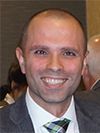November has become one of the most challenging months for the medical community since the pandemic took hold last spring.
The number of COVID cases in Sedgwick County has surged, filling up hospital ICUs at both Ascension Via Christi and Wesley Healthcare and stressing an already tired and overburdened health system.
Hospitals were reporting more than 100 COVID patients by the first week of November. By the middle of November, the total topped 200. With an uptick of nurses and other staff also out sick, physicians and other clinical workers in the ICUs are working practically nonstop.
“We’re overwhelmed and worn out,” wrote Chloe Steinshouer, MD, ICU medical director at Wesley Medical Center, in a Facebook post detailing her experiences treating COVID. “And there’s no end in sight.”

By the second week in November, the rolling 14-day average of positive COVID-19 tests exceeded 20%, according to the Sedgwick County COVID-19 Dashboard.
These numbers helped fuel a new emergency public health order by Garold Minns, MD, effective Nov. 13 that set stricter limits on mass gatherings and imposed an earlier curfew of 11 p.m. on restaurants, bars and nightclubs. Retail stores now are required to enforce mask-wearing.
“COVID-19 is surging through our community,” said MSSC President Patricia Wyatt-Harris, MD. “Though these restrictions create some hardships, they are needed to help slow the spread of the virus. Dr. Minns deserves our support and appreciation for his efforts to protect our community.”

As COVID cases increase, hospitals continue to struggle with the challenge of finding ICU beds for the sickest patients while protecting staff and others from contracting the disease. At a Sedgwick County Board of County Commission special meeting on Nov. 5, Ascension’s Chief Clinical Officer Sam Antonios, MD, said he was worried about the increasing numbers of COVID patients.
“The number of hospitalizations is concerning,” he said. “The reality is there is no ceiling to this.”
Wesley’s Chief Medical Officer Lowell Ebersole, DO, agreed.
“We’re worried about the rise in the number of COVID cases, and we are worried about having enough capacity to care for all of the patients needing care, with or without COVID-19,” Ebersole said. “We need your help to get this pandemic under control in our community.”
This month, the Centers for Disease Control and Prevention filed several scientific briefs and updates online detailing findings and recommendations about COVID-related issues, including detailed benefits to people who wear masks, the long-term effects of COVID-19, the science surrounding COVID-19 infections in children and recommendations for labs looking into reinfections.
“Experimental and epidemiological data support community masking to reduce the spread of SARS-CoV-2,” CDC officials wrote in their Nov. 10 update on community use of cloth masks to control the spread of COVID. “Adopting universal masking policies can help avert future lockdowns, especially if combined with other non-pharmaceutical interventions such as social distancing, hand hygiene, and adequate ventilation.”
This is what Minns was trying to convey by tightening restrictions and consistently reminding people to take masking and social distancing seriously in public places or at family gatherings. He asks physicians to remain vigilant.
“Things are really serious now and all physicians need to help convince their patients that everyone needs to cooperate with the directives if we are to get things under control,” Minns said. “We need to educate the public how close we are to a real limit on our capacity.”
He also is particularly concerned about this year’s holiday season, when families traditionally like to get together.
“The upcoming holidays have the potential to increase the number of cases even more,” Minns said. “We have a lot of asymptomatic carriers who don’t even know they are spreading it as they sit around the dinner table.”
Sedgwick County is on a dangerous trajectory, the MSSC Board of Directors agreed. Citing concerns over the uptick in new positive cases and the challenges Sedgwick County’s hospitals are facing, the board urged both physicians and the public to step up their support of prevention efforts.
“It is imperative that our community redoubles its effort to limit the spread of this virus,” the MSSC board said. “It’s also important not to put off needed medical care, including preventative care. Please wear a mask, practice social distancing, avoid crowds, and wash your hands frequently. Lives depend on it.”
CDC provides clinical tips
- To read the full tip sheet for physicians, please visit https://tinyurl.com/CDCtipsMSSC.
- The National Institutes of Health has developed guidance on treatment, which is regularly updated.
- Non-respiratory symptoms of COVID-19 (gastrointestinal, neurologic, etc.) may appear before fever and lower respiratory tract symptoms.
- Clinicians should be aware of the potential for some patients to rapidly deteriorate one week after illness onset.
- The median time to acute respiratory distress syndrome (ARDS) ranges from 8 to 12 days.



